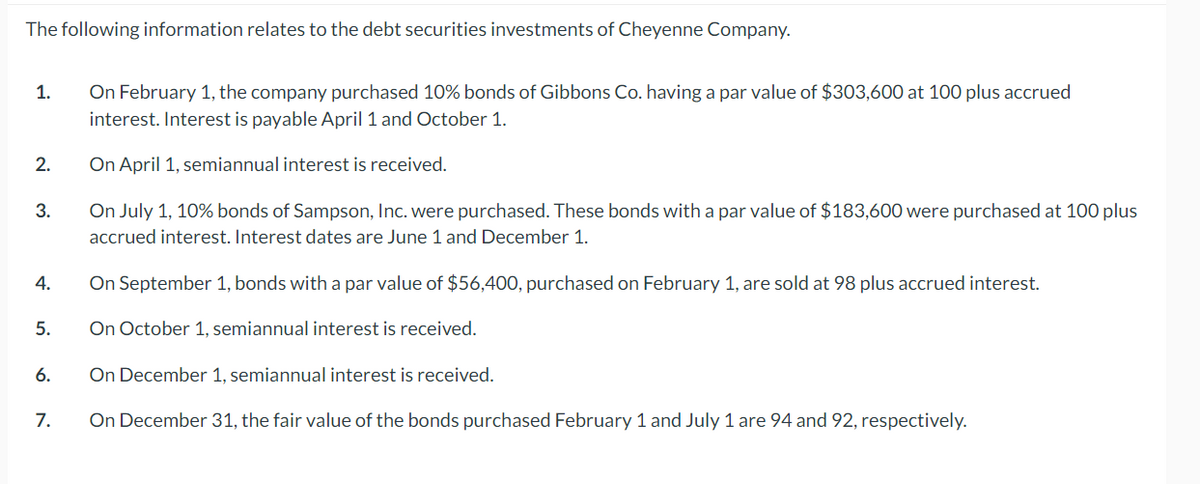The following information relates to the debt securities investments of Cheyenne Company. 1. 2. 3. 4. 5. 6. 7. On February 1, the company purchased 10% bonds of Gibbons Co. having a par value of $303,600 at 100 plus accrued interest. Interest is payable April 1 and October 1. On April 1, semiannual interest is received. On July 1, 10% bonds of Sampson, Inc. were purchased. These bonds with a par value of $183,600 were purchased at 100 plus accrued interest. Interest dates are June 1 and December 1. On September 1, bonds with a par value of $56,400, purchased on February 1, are sold at 98 plus accrued interest. On October 1, semiannual interest is received. On December 1, semiannual interest is received. On December 31, the fair value of the bonds purchased February 1 and July 1 are 94 and 92, respectively.
The following information relates to the debt securities investments of Cheyenne Company. 1. 2. 3. 4. 5. 6. 7. On February 1, the company purchased 10% bonds of Gibbons Co. having a par value of $303,600 at 100 plus accrued interest. Interest is payable April 1 and October 1. On April 1, semiannual interest is received. On July 1, 10% bonds of Sampson, Inc. were purchased. These bonds with a par value of $183,600 were purchased at 100 plus accrued interest. Interest dates are June 1 and December 1. On September 1, bonds with a par value of $56,400, purchased on February 1, are sold at 98 plus accrued interest. On October 1, semiannual interest is received. On December 1, semiannual interest is received. On December 31, the fair value of the bonds purchased February 1 and July 1 are 94 and 92, respectively.
Financial Accounting
14th Edition
ISBN:9781305088436
Author:Carl Warren, Jim Reeve, Jonathan Duchac
Publisher:Carl Warren, Jim Reeve, Jonathan Duchac
Chapter15: Investments And Fair Value Accounting
Section: Chapter Questions
Problem 5E
Related questions
Question
Do not give solution in image

Transcribed Image Text:(a)
Prepare any journal entries you consider necessary, including year-end entries (December 31), assuming these are available-for-sale
securities. (Note to instructor: Some students may debit Interest Receivable at date of purchase instead of Interest Revenue. This
procedure is correct, assuming that when the cash is received for the interest, an appropriate credit to Interest Receivable is
recorded.) (Credit account titles are automatically indented when amount is entered. Do not indent manually. If no entry is required, select "No
Entry" for the account titles and enter O for the amounts.)

Transcribed Image Text:The following information relates to the debt securities investments of Cheyenne Company.
1.
2.
3.
4.
5.
6.
7.
On February 1, the company purchased 10% bonds of Gibbons Co. having a par value of $303,600 at 100 plus accrued
interest. Interest is payable April 1 and October 1.
On April 1, semiannual interest is received.
On July 1, 10% bonds of Sampson, Inc. were purchased. These bonds with a par value of $183,600 were purchased at 100 plus
accrued interest. Interest dates are June 1 and December 1.
On September 1, bonds with a par value of $56,400, purchased on February 1, are sold at 98 plus accrued interest.
On October 1, semiannual interest is received.
On December 1, semiannual interest is received.
On December 31, the fair value of the bonds purchased February 1 and July 1 are 94 and 92, respectively.
Expert Solution
This question has been solved!
Explore an expertly crafted, step-by-step solution for a thorough understanding of key concepts.
This is a popular solution!
Trending now
This is a popular solution!
Step by step
Solved in 2 steps

Knowledge Booster
Learn more about
Need a deep-dive on the concept behind this application? Look no further. Learn more about this topic, accounting and related others by exploring similar questions and additional content below.Recommended textbooks for you

Financial Accounting
Accounting
ISBN:
9781305088436
Author:
Carl Warren, Jim Reeve, Jonathan Duchac
Publisher:
Cengage Learning

Cornerstones of Financial Accounting
Accounting
ISBN:
9781337690881
Author:
Jay Rich, Jeff Jones
Publisher:
Cengage Learning

Principles of Accounting Volume 1
Accounting
ISBN:
9781947172685
Author:
OpenStax
Publisher:
OpenStax College

Financial Accounting
Accounting
ISBN:
9781305088436
Author:
Carl Warren, Jim Reeve, Jonathan Duchac
Publisher:
Cengage Learning

Cornerstones of Financial Accounting
Accounting
ISBN:
9781337690881
Author:
Jay Rich, Jeff Jones
Publisher:
Cengage Learning

Principles of Accounting Volume 1
Accounting
ISBN:
9781947172685
Author:
OpenStax
Publisher:
OpenStax College

Excel Applications for Accounting Principles
Accounting
ISBN:
9781111581565
Author:
Gaylord N. Smith
Publisher:
Cengage Learning

Financial Accounting
Accounting
ISBN:
9781337272124
Author:
Carl Warren, James M. Reeve, Jonathan Duchac
Publisher:
Cengage Learning

Intermediate Accounting: Reporting And Analysis
Accounting
ISBN:
9781337788281
Author:
James M. Wahlen, Jefferson P. Jones, Donald Pagach
Publisher:
Cengage Learning